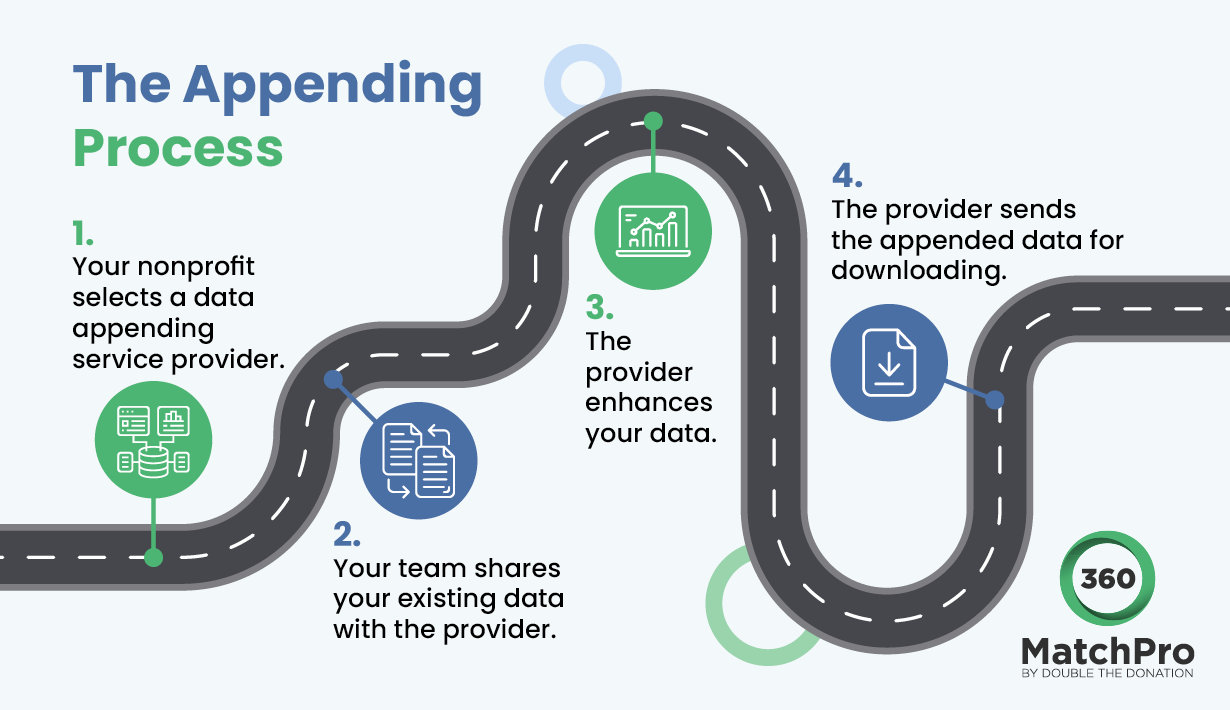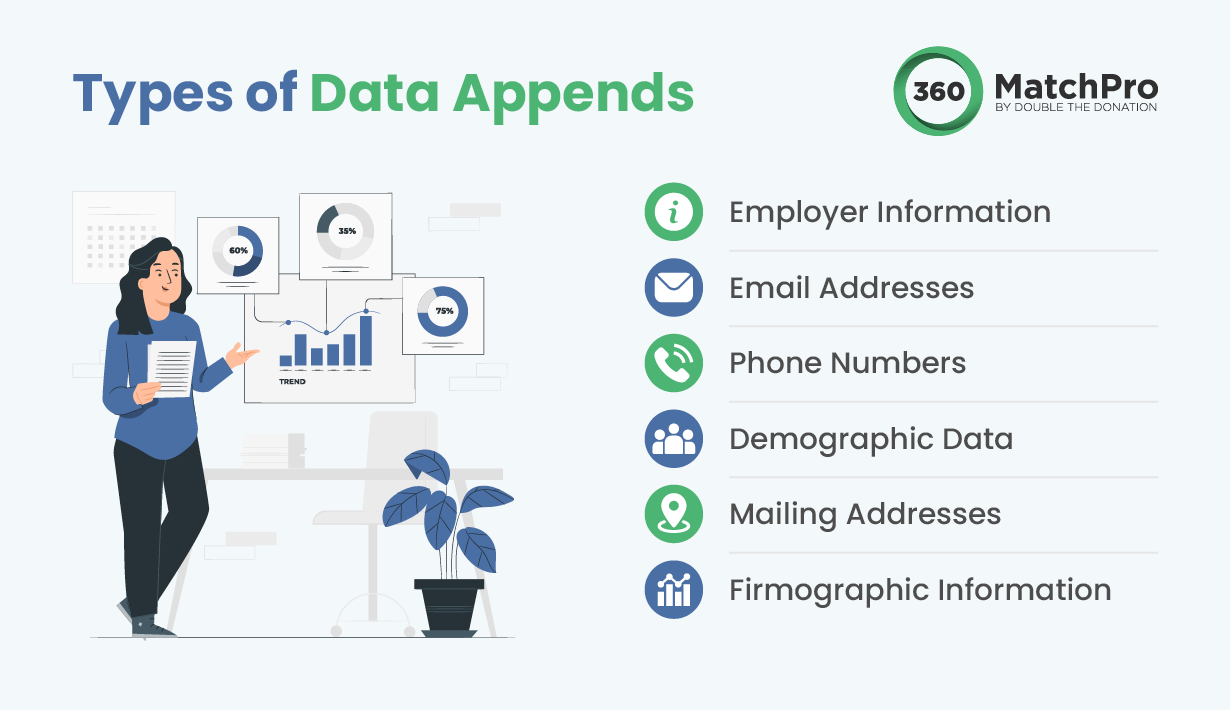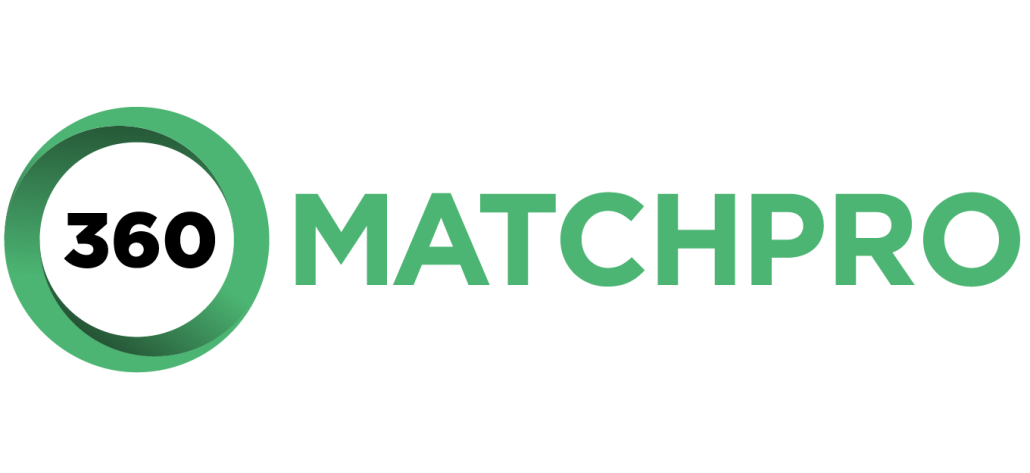What is Data Appending? Basics, Benefits, and Best Practices
Every day, your nonprofit has a lot of decisions to make. Should your next fundraising event be in person or virtual? How can you convince more donors to increase their giving? Who should you approach for corporate sponsorships? Your donor database should contain the answers to all of these questions (and more), but sometimes, it’s not enough. Email lists become outdated, phone number fields are left blank, and supporters change addresses. That’s why data appending services exist.
All types of organizations, including nonprofits, businesses, and educational institutions, rely on data appends to maintain accurate and functional databases. In this guide, we’ll explore the basics of data appending and how your nonprofit can use it to boost your donor engagement, fundraising, and marketing results. Here’s what we’ll cover:
- Data Appending: FAQs
- Common Types of Data Appends
- How to Choose a Data Appending Service
- Data Appending Best Practices
With data you can trust, your team can make more informed decisions and direct your resources to where they matter most.
Data Appending: FAQs
At first glance, the word “data” can seem intimidating, calling to mind images of complicated charts and graphs. Data appending, however, is designed to make your team’s lives easier. Let’s break down the concept by walking through some frequently asked questions:
What is data appending?
A data append refers to the process of pulling data from external sources to update or fill in gaps in your database. Through data appending services, your nonprofit can learn more about its donors, such as how to reach them and ways to tailor your messaging to elicit responses.
Consider the types of donor data that would be most beneficial to your nonprofit. Many organizations append data such as:
- Employment details, to identify corporate giving opportunities and connections to leverage for potential sponsorships.
- Contact information, including email addresses and phone numbers.
- Demographic details, such as location and birthdate, for sending more targeted, segmented communications.
For example, let’s say that your nonprofit is about to launch a mentoring program to support youth in your local community. You’re looking for donors to help get your program off the ground and volunteers to serve as mentors. By identifying people in your database who live in your area through an address append, you can focus your outreach on local individuals who are more likely to participate in and care about your initiative.
Why should you append data?
An accurate and comprehensive database allows your nonprofit to make more strategic decisions across the board. You can automate fundraising messages, expand your marketing content to new channels, and better understand the supporters who make your mission possible.
The following statistics from “The State of Data in the Nonprofit Sector” highlight exactly why data appends are so important for nonprofits:

- 87% of nonprofit professionals agree that data is moderately to extremely important to operations and decision-making.
- However, only 6% of nonprofits feel that they’re effectively using the data at their disposal.
- 36% of nonprofits indicate that they aren’t collecting enough data.
- 79% of nonprofits report that they don’t have enough time or personnel to focus on data.
Even if your nonprofit is short on time and staffing, that doesn’t mean you have to sacrifice the quality of your data and strategies. Think of your database as a puzzle. Data appending helps find the missing pieces, bringing you closer to completion.
When should you conduct a data append?
Since you can append so many different types of data, data appending services present almost endless possibilities for your nonprofit. Several reasons that might lead you to append your data include:
- Missing information. Depending on the forms your supporters fill out, you might only receive a donor’s email address but no phone number or mailing address. Data appends provide you with a more complete picture to guide your interactions.
- Outdated details. People often move, switch email addresses, or change phone numbers. However, donors may not always remember to update their information with your nonprofit. Appending your data allows you to maintain relationships year after year by ensuring that you always have donors’ latest contact details.
- Need for more donor insights. Since donors are the cornerstone of your nonprofit’s long-term success, you must keep their preferences and needs in mind with every decision you make. Whether you’re trying to choose what type of event to plan or which donor recognition strategies to employ, data appending can unlock new insights to better understand what will appeal to your donors.
Ultimately, data appends lead to a more comprehensive database, which in turn powers your nonprofit’s relationship-building with donors.
What does the data appending process look like?
If you’re new to the concept of data appending, it can seem mysterious. Your nonprofit starts with its current state database, and somehow, you walk away with new, expanded donor records. To dispel some of the mystery, let’s break down the data appending process into basic steps:

- Your nonprofit selects a data appending service provider. The provider will facilitate the appending process by referencing external databases and supplying your nonprofit with information that is accurate, compliant with data regulations, and presented in a consistent format.
- Your team shares your existing data with the provider. You’ll upload your data records in a consistently formatted file and share it with the provider. They will then match these records with entries in their external databases to gather additional details about your donors.
- The provider enhances your data. Depending on the type of data appends you’ve requested, the provider will fill in these missing details and correct any outdated information as needed.
- The provider sends the appended data for downloading. You can access these improved, expanded records through a downloadable file or an online portal.
As you can see, the entire data appending process requires very little time or effort on your nonprofit’s part. The key takeaway is that the more information you provide upfront, the easier it will be for your provider to find record matches and enhance your database with fresh, accurate details.
Common Types of Data Appends
There are numerous types of data appends your nonprofit can choose from. Depending on your outreach and marketing goals, you might be interested in:

1. Employer Appends
For many donors, their potential social impact goes beyond individual donations. More than 26 million individuals work for companies that have matching gift programs—meaning their employers will match the gifts they make to nonprofits—but 78% are unaware of these opportunities.
Through employer appends, your nonprofit can collect employment details to:
- Promote matching gift opportunities. One in three donors report that they would make a larger gift if they knew it would be matched by their employer. If you know which donors work for companies with matching gift programs, you can encourage them to check their eligibility and submit a matching gift request for your nonprofit.
- Follow up about volunteer grants. Similar to matching gifts, volunteer grants involve companies donating to your nonprofit after one of their employees volunteers a certain number of hours with your organization. Help your committed volunteers deepen their impact by making them aware of any volunteer grant opportunities their company might offer.
- Identify potential corporate partners. As corporate social responsibility (CSR) becomes an increasing priority around the world, many companies are drawn to supporting the causes their employees care most about. If many of your donors or volunteers work for a certain company, you could reach out to secure a potential sponsorship.
- Estimate giving capacity. A donor’s place of employment and job title can hint at their giving capacity and net worth. With these insights, you can better engage them with outreach and send them targeted appeals.
Let’s say that your nonprofit has a strong volunteer base, and you would like to convert some of these individuals into donors. By appending their employment information, you could pinpoint those who work for companies with matching gift programs and mention the opportunity in your appeals. Since it’s clear that your volunteers are already committed to your mission, chances are they’ll jump at the opportunity to amplify their impact.
2. Email Appends
According to ZeroBounce’s Email List Decay Report, at least 25.74% of an email list degrades every year. Many people change or lose access to their email addresses, making it challenging to keep all of your records up to date. However, email is essential for communicating with your donors, allowing you to maintain and strengthen these vital relationships over time.
The solution to this persistent issue? Email appends. By appending email addresses, your nonprofit can:
- Make the most of a multichannel marketing strategy. Donors have varying communication preferences. For those in your community who tend to check their email most often, email appending ensures that you can always reach them at the right place.
- Stay in touch with donors, volunteers, and event attendees. Your nonprofit interacts with a variety of supporters throughout the year. No matter how they’re introduced to your mission, having their email addresses on hand ensures that you can follow up with relevant updates that keep your organization top of mind.
- Share surveys and encourage feedback. Emails allow your nonprofit to turn your donor communications into a two-way street. With accurate emails and segmentation, you can create and send surveys to relevant members of your audience, such as event attendees and volunteers. By collecting their input, you can identify ways to improve their experiences with your nonprofit going forward.
It’s common for some donors to lapse, but that doesn’t mean that you can’t re-engage them. Some individuals may have fallen out of touch with your organization after changing their email address and losing access to your regular email updates. By reaching out to their most recent email address, you can share upcoming engagement opportunities they might be interested in and inspire them to get involved again.
3. Phone Number Appends
The average American spends over six hours on their phone every day, which adds up to about 70 days per year. By collecting and maintaining accurate donor phone numbers, you can interact with them where they spend so much of their time.
Appending phone numbers allows your nonprofit to:
- Share emergency updates. Some fundraisers and programs necessitate getting in touch with your supporters quickly. For instance, on Giving Tuesday, you might send a text message when there are just a few hours left for supporters to get their donations in.
- Launch text campaigns. Text messages can complement your email, direct mail, and social media outreach efforts to raise awareness and earn donations.
- Stay in touch with key supporters. There may be times when you need to reach out to specific supporters quickly, and a phone call or text message can accomplish just that. Text your volunteers when a shift falls through and you need a replacement, or give a major giving candidate a call to set up a one-on-one meeting.
When it comes to text outreach, be conscious of over-messaging. While it’s possible to over-message on any platform, it’s especially noticeable for text messages because supporters almost always have their phones ready and notice when messages come in.
Be strategic about when you send text messages and thoughtful about when competition for donors’ attention might be high. For example, during election seasons, your supporters likely receive text messages from political candidates vying for their donations.
4. Demographic Appends
The more you know about your supporters, the better you’ll be able to build relationships with them. With demographic information, you can make inferences about your supporters’ interests, values, and contribution capacity.
Data provided in a demographic append might include:
- Net worth
- Age and birthday
- Gender
- Ethnicity
- Income
- Marital status
- Family status
- Religion
- Purchasing habits
- Hobbies and interests
Use this information to group your donors into relevant segments. For example, you might make a donor segment for supporters with children. Then, when a family-friendly event pops up, you would send personal invitations to the supporters you know are most likely to say yes due to their family status.
5. Address Appends
In 2023, there were more than 33 million address changes. As such, chances are that a significant number of your supporters will move every year, and they may not remember to update your nonprofit on their new address.
With an address append, you can ensure your direct mail outreach will always find your supporters with every move. Outside of direct mail communication, address appends also help you identify your supporters’ geographic area, which can impact your event planning and volunteer outreach efforts.
6. Firmographic Appends
If you’re on the hunt for corporate sponsorships or partnerships, consider purchasing a firmographic append. While the previous appends are used to find information on individuals, firmographic appends uncover information about organizations.
For instance, a firmographic append might report an organization’s:

- For- or nonprofit status
- Public or private status
- Address
- Phone number
- Website
- Number of employees
- Industry
- Annual sales
Firmographic appends provide the data you need to get in touch with businesses, as well as information vital for assessing whether a business is a prospective sponsor. For instance, a firmographic append can indicate whether a business is growing, declining, or static. This allows you to identify financially stable sponsor prospects who are more likely to agree to a donation request.
How to Choose a Data Appending Service
Data appending services specialize in different aspects and types of appending. When assessing prospective providers, look for one that:
- Offers multiple appending services. If you find a data appending service you like, you can return to them for other appends in the future. Search for providers that offer appends for a wide range of data. Keep in mind that some types of appends, such as employer and firmographic appends, are more specialized and may not be offered widely.
- Follows privacy regulations. As part of the data appending process, you will need to share your supporters’ identifying information with your service provider. Additionally, data appending providers will pull information from multiple databases to find your supporters’ data. As such, ensure you partner with a provider that takes data security seriously and follows relevant privacy regulations like GDPR and CCPA.
- Provides accurate information quickly. It’s essential you receive your appended data quickly to make use of it, but also be conscious of the disadvantages of hastily compiled appends. Some append providers will add confidence ratings to their appends, indicating how sure they are that the information is correct.
When it comes to data appending providers, we have to recommend our team at Double the Donation. We specialize in employer append data. With over a decade of experience in the nonprofit sector, we’ve worked with countless nonprofits to supplement their supporters’ employer data to help them unlock grant and funding opportunities.
3 Best Practices for Making the Most of Your Data Appends
Ultimately, appends are just data, and how valuable they are depends on how your nonprofit uses them. To ensure you request information that will assist your operations and put it to good use, follow these best practices:
- Clean your data. While you don’t need to clean your data before requesting an append, doing so will make the process go more smoothly. Practice good data hygiene by performing a data audit to identify information that’s incorrect, missing, duplicated, or unnecessary. As part of this process, remove useless information and make notes of data your append can correct.
- Know what data you need. Before approaching an appending service, be sure that purchasing an append is the right decision for your nonprofit at this time. For example, it may make sense to routinely get appends for contact information. However, demographic information is unlikely to significantly change year-over-year, and you might only request that service after earning a large number of new supporters.
- Plan your migration process. Your data append provider should return your appended data in a format compatible with your donor database. Ensure you have a process for syncing this information to update automatically and avoid a manual migration.
Once you receive the appended data, it’s up to your nonprofit how it will be used. Make strategic decisions about which supporters to reach out to, what platforms to use, and when is the right time to make contact.
Wrapping Up: Making Informed Decisions with Data Appending
Data appending supercharges your nonprofit’s data-gathering abilities by providing your organization with high-quality, accurate information on demand. To decide if purchasing a data append is right for you, consider your outreach and marketing needs and whether a data update can improve them. Then, start researching providers to find one that meets your nonprofit’s standards.
For more resources related to data appending, explore these complete guides:
- Alumni Data Appends: Connect With Your University’s Donors. Universities and colleges can benefit from specialized data appends for their alumni. If your organization is in the higher ed space, discover how to connect with alumni thanks to data appends.
- How A Corporate Giving Database Unlocks Fundraising Success. Corporate giving databases are an alternative to data appends that provide your nonprofit with continuous information about your supporters’ employers. If your organization is serious about pursuing corporate giving opportunities, this database might be right for you.
- How To Master Nonprofit Data Management: Tips for Success. With your newly appended data, it’s up to your nonprofit to make use of it. Explore tips for keeping your data clean and making it work for your organization.



